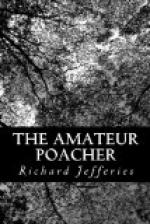The men that are so expert at finding partridges’ eggs to sell to the keepers know well beforehand whereabouts the birds are likely to lay. If a stranger who had made no previous observations went into the fields to find these eggs, with full permission to do so, he would probably wander in vain. The grass is long, and the nest has little to distinguish it from the ground; the old bird will sit so close that one may pass almost over her. Without a right of search in open daylight the difficulty is of course much greater. A man cannot quarter the fields when the crop is high and leave no trail.
Farmers object to the trampling and damage of their property; and a keeper does not like to see a labourer loafing about, because he is not certain that the eggs when found will be conscientiously delivered to him. They may be taken elsewhere, or they may even be broken out of spite if the finder thinks he has a grudge to repay. Now that every field is enclosed, and for the most part well cultivated and looked after, the business of the egg-stealer is considerably diminished. He cannot roam over the country at his fancy; his egg-finding is nearly restricted to the locality of which he possesses minute knowledge.
Thus workmen engaged in the towns, but sleeping several miles out in the villages, can keep a register of the slight indications they observe morning after morning as they cross the fields by the footpath to their labour. Early in the spring they notice that the partridges have paired: as time advances they see the pair day after day in the same meadow, and mark the spot. Those who work in the fields, again, have still better opportunities: the bird-keeping lads too have little else to do at that season than watch for nests. In the meadows the labourer as he walks to and fro with the ‘bush’ passes over every inch of the ground. The ‘bush’ is a mass of thorn bushes fixed in a frame and drawn by a horse; it acts like a light harrow, and leaves the meadow in strips like the pile of green velvet, stroked in narrow bands, one this way, one that, laying the grass blades in the directions it travels. Solitary work of this kind—for it requires but one man—is very favourable to observation. When the proper time arrives the searcher knows within a little where the nest must be, and has but a small space to beat.
The pheasant being so large a bird, its motions are easy to watch; and the nest is speedily found, because, being in the hedge or under bushes, there is a definite place in which to look, instead of the broad surface of the field. Pheasants will get out of the preserves in the breeding season and wander into the mounds, so that the space the keeper has to range is then enlarged threefold. Both pheasants and partridges are frequently killed on their nests; when the eggs are hard the birds remain to the last moment, and are often knocked over.




